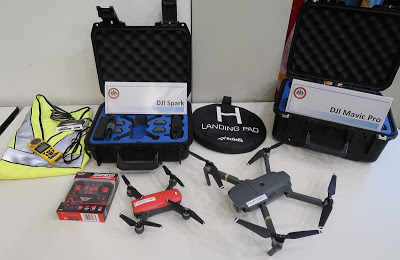Fairfax County considers drone program
 |
| Drones from the private collection of Roy Shrout. |
Fairfax County’s police, fire, and emergency management departments are seeking approval from the Board of Supervisors for a drone program to help with such functions as search and rescue and disaster response.
Several county officials explained the unmanned aircraft system (UAS) proposal at a community meeting Feb. 4 at the Mason Government Center. (That meeting, originally set for Jan. 14, was postponed due to winter weather.)
The proposal calls for the Fire and Rescue Department to have four drones. The Office of Emergency Management (OEM) would have two, and the Police Department would have two to four, said Roy Shrout, deputy coordinator at OEM.
The police would use the drones for searching for missing persons, surveying accident scenes, traffic assessments, crash reconstruction, and forensics documentation.
The fire department would use them for investigating fires, ground operations during fires, accidents involving hazardous materials, investigating blasting sites, and carrying out search and rescue missions. OEM would use them for damage assessments in the case of natural disasters or other emergencies.
“Privacy is a huge issue,” said Mason Supervisor Penny Gross. As a result, policies will be established to outline how the drones can be used (and not used) and how long data and images will be kept.
The drones are just another tool for the police, said David Rohrer, deputy county executive for public safety and former Fairfax County police chief. “Don’t think about predator drones” like those used by the military, he said. The county’s drones won’t be used for surveillance or to catch speeders and “won’t be weaponized.”
In most cases, drones could only be used when there is a search warrant, Rohrer said, but exceptions would be allowed when there is an amber alert, an officer is attacked, a senior is missing, or when there is an immediate threat to any person, such as an active shooter, barricade situation, or suicide threat.
If a drone is misused by the police, any evidence obtained by the drone could not be used as evidence in a criminal case, he said.
One issue that needs to be addressed is conflicts with privately operated drones, said Maj. Christian Quinn of the FCPD. The county’s drones will be clearly marked. Individuals who fly their drones near an emergency incident will be asked to step back or operate their drones at a different altitude, he said.
Quinn said a drone could have been helpful in investigating a series of incidents in 2018 when shots were fired at Goodwin House in Bailey’s Crossroads; it was difficult for police to examine the damage in the building’s upper floors. In another example, a drone could be used to assess the situation when a tree falls on a house without having to send an officer inside.
Drones are just another tool for public safety personnel; they won’t replace the police helicopters or anything else, Quinn said. In fact, they will make the police department more efficient and improve public safety.
A drone could reduce the time for a crash reconstruction from three hours to one hour, for example, he noted, and could reduce the time it takes to locate missing persons.
The program would cost about $45,000 for the first year, which would cover six to eight drones and accessories, training, insurance, and the $150 cost per drone pilot for certification by the Federal Aviation Administration.
All drones would have to be less than 55 pounds. (The drones on display at the meeting were no bigger than a bread box.) Maximum altitude would be 400 feet above the ground or the tallest structure. All flights would be within a visual line of sight.
Shrout recounted the history of the drone proposal: The Board of Supervisors formed a work group in 2017 to consider a UAS program. The group included representatives from the police department, fire and rescue department, sheriff’s office, county attorney’s office, urban search and rescue team, park authority, risk management department, and public affairs department.
That group reviewed best practices, went on site visits, looked at UAS systems already established in Virginia, and considered training needs, privacy and transparency concerns, and other issues.
The BoS deferred a decision on the program in July 2018 and created a task force with representatives from the ACLU, FAA, Audubon Society, Leadership Fairfax, Communities of Trust, NAACP, and other groups, as well as county agencies, to further study a UAS program.
The task force is tentatively scheduled to present its recommendations to the board’s Public Safety Committee March 12.
If the board approves a UAS program, the county would set up a steering committee that could include members of the task force and work group to determine which drones to purchase, submit the required paperwork to the FAA, set up a training program, develop policies on privacy and data collection, and host a half-day summit open to the public.
The county will need to get a waiver from the FAA to fly drones within the restricted airspace covering a 15-mile radius around Reagan National Airport. Drones are allowed within a 30-mile radius under certain conditions.
If the UAS program proves successful, Shrout said, it could be expanded to additional uses, such as wildlife population estimates, stream and water management, aerial mapping, and infrastructure assessment.

